
Directions
-

SoC Faculty Hosted APSEC 2023 International Confer..
Conference (APSEC 2023) organized by our School of Computing professors took place at Grand Walkerhill Seoul. Professor In-Young Ko served as the General Chair, while Professors Jeehoon Kang, Jongmoon Baik, Shin Yoo, and Eunkyoung Jee participated as organizing committee members. This international conference, now in its 30th edition, is a prominent event in the field of software engineering. With over 300 attendees from 23 countries, the conference featured over 90 papers presented across various tracks. Special programs such as the Student Research Competition (SRC) and Most Influential Papers (MIPs) were included to commemorate the 30th anniversary. The conference kicked off on Monday, December 4th, with workshops, tutorials, and the SRC session. Tuesday, the first day of the main conference, began with an opening ceremony, followed by the first keynote speech, paper presentations, and a reception. Wednesday featured a keynote speeche, paper presentation sessions, the MIPs session, and a banquet. The event concluded on Thursday with the third keynote speech, paper presentation sessions, a closing ceremony, and a farewell. After three years of being held online due to COVID-19, APSEC 2023 returned to an in-person format. It provided researchers in the field of software engineering from around the world with a rare opportunity to engage in vibrant research exchanges and social interactions. Attendees also had the chance to experience Korean culture and cuisine. APSEC 2023 Homepage: https://conf.researchr.org/home/apsec-2023
...Read more -

Jong Cheol Park, Professor of School of Computing ..
https://2023.emnlp.org/program/keynotes/ Jong Cheol Park, Professor of School of Computing at KAIST, will deliver a Keynote Speech entitled "Human-Centric Natural Language Processing" at EMNLP 2023 in Singapore as follows. In keeping up with the three pillars of natural language processing, ever-changing principles and techniques, emerging domains of application and related resources, and people with various needs for language support, our research team has paid particular attention to the third pillar with a special focus on human-centric diversity and minority issues, including children, experts in biology and medicine, deaf people, and people with different challenges to language use. In this talk, I wish to share our achievements along the way, recently leading to a flurry of pleasant results that make use of deep learning techniques and large language models. I conclude the talk with a cautious prognosis about what might lie beyond large language models that loom over much of what we do at the moment and may hamper diversity to a worrisome degree and even humanity in hindsight.
...Read more -

Paper from the NLP*CL Lab in the School of Computi..
Fitsum Gaim, Wonsuk Yang, and Hancheol Park, under the guidance of advisor Professor Jong C. Park from the School of Computing at KAIST, have received the 'Outstanding Paper Award' at the Association for Computational Linguistics (ACL) 2023 Conference held in Toronto, Canada, from July 9th to July 14th, 2023. Their groundbreaking work, entitled “Question-Answering in a Low-resourced Language: Benchmark Dataset and Models for Tigrinya,” focuses on the under-studied East-African language Tigrinya, which is spoken in the countries Eritrea and Ethiopia. The team created the first question-answering dataset for the language and developed language models that can answer questions by reading Tigrinya documents. This recognition was given only to the top 1.5~2.5% of the total submissions to the conference. The team's work builds upon their previous efforts in introducing the first Pre-trained Language Models and Language Identification methods for Tigrinya and other East-African languages, which were presented at well-reputed conferences like LREC 2022 and EMNLP 2021. Fitsum, the first author, is a Ph.D. candidate with the NLP*CL Lab. While his work focuses on Tigrinya, the far-reaching effects of the team’s research extend well beyond this specific language. The methodologies, data collection methods, annotation tools, and models they have developed can serve as beneficial references for other underrepresented languages, particularly across Africa and Asia. Their work attempts to bridge the stark digital divide, offering linguistically diverse and historically disadvantaged communities an equitable digital representation. The team's contributions further demonstrate the transformative potential of Artificial Intelligence and Natural Language Processing. By working not just on popular, high-resourced languages, but turning their attention to low-resourced languages, they highlight the multidimensionality of the field and reflect the diverse realities of the global community. This work is among the five long papers that are presented by the NLP*CL Lab at ACL 2023, three at its main conference and two at its Findings.
...Read more -
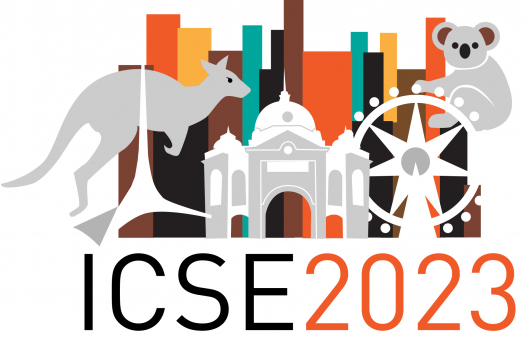
KAIST's School of Computing published a number of ..
KAIST's School of Computing published a number of excellent research at the International Conference on Software Engineering (ICSE 2023). Jaemin Hong, a Ph.D. student at the PLRG lab (supervisor Sukyoung Ryu), contributed to the problem of converting old legacy programs into Rust, which is safer, by proposing a technology that accurately solves concurrent problems when automatically converting programs written in C language into Rust. Sungmin Kang and Juyeon Yoon, Ph.D. students at the COINSE lab, introduced a technology that significantly improves developers' debugging efficiency by automatically synthesizing tests that reproduce them from bug reports written in natural language using large-scale language models. Gabin Ahn, a Ph.D. student (supervisor Shin Yoo) and Naryeong Kim, an undergraduate at the same lab, proposed a technology that can contribute to improving code quality by accurately identifying when defect codes were first written in the program. The International Conference on Software Engineering, which is one of the best conferences in software engineering, will be held in Melbourne, Australia, from May 14 to 20, marking its 45th anniversary this year.
...Read more -

KAIST, a Joint Business Agreement on the Developme..
This is an article about AutoID Lab's the joint smartship platform development agreement with the shipbuilding, maritime, and port-related organizations. AutoID Lab s headed by Daeyoung Kim, professor of School of Computing. Related Articles: https://www.etnews.com/20221207000070 KAIST participates in research in the field of international standard data platforms and AI.
...Read more -

Jongmoon Baik, Professor of School of Computing Wa..
Reference : https://www.korea.kr/news/pressReleaseView.do?newsId=156541987 Jongmoon Baik, professor of School of Computing was selected as the "50 outstanding achievements on academic and research support project" announced by the Ministry of Education today. Researchers selected for 50 outstanding achievements will be given benifits by giving additional points when selecting new academic and research support projects in the future. The Ministry of Education selected 50 outstanding achievements on academic and research support projects in 2022 and will hold an award ceremony at the Eliena Hotel (Gangnam-gu, Seoul) on December 13 (Tue). The Ministry of Education is supporting academic and research support projects to encourage creative knowledge and induce balanced academic development, and provided a total of 854.6 billion won in 34 projects in each field, including humanities, science and engineering, and Korean studies, in 2021. Through this, 154 candidates out of 12,000 academic and research projects were submitted through public offerings and recommendations, and 50 outstanding achievements (26 in humanities, 20 in science, and 4 in Korean studies) were finally selected through comprehensive evaluation*
...Read more -

Best Paper Award at International Conference on Me..
At "The 3rd International Conference on Medical Imaging and Computer-Aided Diagnosis" (MICAD), which was held as a hybrid at the University of Leicester in the U.K. from November 20th to 21st, Jihoon Cho (PhD program) (advised by Jinah Park) received "Best Paper Award" with his paper "Hybrid-Fusion Transformer for Multisequence MRI". The MICAD International Conference was approved by the MICCAI Society, the world's leading medical image computing and computer-assisted medical intervention association, for this year's 2022 conference. The conference covers various fields, such as medical imaging, electronics, computer-assisted diagnostics, physics, and machine learning that connect computer science and medical feild. MRI, which non-invasively photographs the inside of the body and reconstructs the inside of the body into a three-dimensional image, is photographed through various protocols depending on the filming site and purpose. The MRI taken in this way consists of several MRI sequences, and the characteristics shown by each sequences are different. Therefore, integrating these characteristics is the key in medical analysis. In this study, the research team proposed a Hybrid-Fusion method that integrates features between multiple MRI sequences and use it to build a training model, and demonstrate the excellence of the study through quantitative and qualitative evaluation. The results of this study proved their excellence in that MRI has contributed to the development of more advanced medical analysis methods as it is mainly used in various disease analysis.
...Read more -

KAIST Proves Its Research Capabilities at the Inte..
https://news.kaist.ac.kr/news/html/news/?mode=V&mng_no=25630 ※ This is news about NeurIPS 2022 in which Professor Haeyun Oh and Alumni Kyunghyun Cho took chrage of PC(Program Chair), and Professor Sungjin Ahn took charge of the Workshop Chair. Photo Researcher Team at our university have proven their active research capabilities and status at the NeurIPS, which boasts the world's highest authority in the field of artificial intelligence. NeurIPS is a prestigious international conference that publishes the latest artificial intelligence research in industry and academia. Our university published 20 papers in 2020 and 45 papers in 2021, and this year published 37 papers similar to last year to show its robust research capabilities in the field of artificial intelligence. In particular, a paper written by Jongchul Ye, a professor at AI Graduate School, "Energy-Based Contrastive Learning of Visual Representations", was selected as a verbal presentation paper that selects only the top 6%, and was recognized for its excellent quality of research. In addition, the faculty and alumni of our university were remarkably active at the NeurIPS 2022 held in New Orleans, Louisiana, from the 28th of last month. Haeyun Oh, professor of School of Computing (vice president of KAIST Artificial Intelligence Research Institute) and alumni Kyunghyun Cho (graduate of KAIST's School of Computing) served as the Program Chair, while Sungjin Ahn, professor of School of Computing served as the Workshop Chair. Juho Kim, professor of School of Computing was invited as a keynote speaker and presented under the theme of "Interaction-Central AI". Professor Heayun Oh explained, "A number of KAIST researchers were selected as organizers and keynote speakers of the international conference. This shows that status of KAIST in the field of artificial intelligence research has increased worldwide."
...Read more -
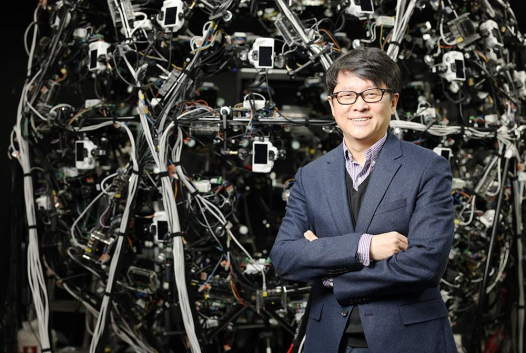
Professor Minhyuk Kim won the Best Invention Award..
Minhyuk Kim, a professor of computer science at KAIST, was selected as the best prize at the "10th Industrial-Academic Research Project Excellent Invention" award held by SK Hynix. Professor Minhyuk Kim, who was selected as the best prize, developed a technology to reduce noise related to CIS (CMOS image sensor) video. The technology was highly evaluated because it is likely to be applied to actual products. In addition, Hanyang University professor Jaedeok Han was selected for the Excellence Award, Seoul National University professor Namik Cho, Kyung Hee University professor Woojin Jeon, and Sungkyunkwan University professor Donghee Lee were selected for the Encouragement Award. SK Hynix has been selecting outstanding patents from among patents filed while performing research projects at the University of Industry-Academic Cooperation and awarding them every year since 2013. (Reference) https://m.yna.co.kr/amp/view/AKR20221202083400003
...Read more -

2022 QIFK(Qualcomm Innovation Fellowship Korea)
https://www.qualcomm.com/research/university-relations/innovation-fellowship/2022-south-korea At the Qualcomm Innovation Fellowship Korea 2022 (2022 QIFK), eight papers from KAIST (President Kwanghyung Lee) graduate students were selected, and ten students received research scholarships. Qualcomm Technologies, Inc. annually discovers excellent papers in the fields of artificial intelligence, machine learning, and autonomous driving in Korea and delivers scholarships through Qualcomm AI Research. Two of the eight papers from KAIST were written by graduate students in the Department of Computer Science and were all selected as finalists at Qualcomm Innovation Fellowship Korea 2022. Juil Koo (Master program) Jinwoo Kim (PhD program) Juil Koo (advised by Minhyuk Sung) wrote a paper about finding 3D object part from natural language (PartGlot: Learning Shape Part Segmentation from Language Reference Games, CVPR 2022). Jinwoo Kim (advised by Seunghoon Hong) wrote a paper that expands the Transformer neural network to set, graph, and hypergraph data (Transformers Generalize DeepSets and Can be Extended to Graphs and Hypergraphs, NeurlPS 2021). Juil Koo, the only master's student among the Qualcomm Fellowship winners, was selected as an oral paper at The IEEE/CVF Conference on Computer Vision and Pattern Recognition (CVPR) 2022 as the first paper to reveal the part-level dense relationship between natural language and 3D objects. Jinwoo Kim, a Ph.D. student, first expanded the Transformer neural network structure, which supported many innovations in natural language and computer vision, to all kinds of sets, graphs, and hypergraph data based on equivariance theory. This paper was published in NeurIPS (Neural Information Processing Systems) 2021. The Qualcomm Innovation Fellowship aims to encourage graduate students majoring in science and engineering with potential to conduct research that will lead future technologies based on creativity, autonomy, and rich research understanding. The Qualcomm Innovation Fellowship, which began in the United States in 2009, has expanded its scope to award scholarships by selecting graduate students who have written innovative papers in various countries such as Europe, India, and Korea. Qualcomm Innovation Fellowship Korea 2022, held this year, call for papers in the fields of artificial intelligence, machine learning, and autonomous driving for students in master's and doctorate courses in Korea. Among 140 papers, 42 papers were selected as final entries, and the applicants attended offline events to present papers and hold poster sessions. Finally, 20 papers were selected for the fellowship in consideration of the applicants' understanding of research, innovation of research, and potential for future research.
...Read more -
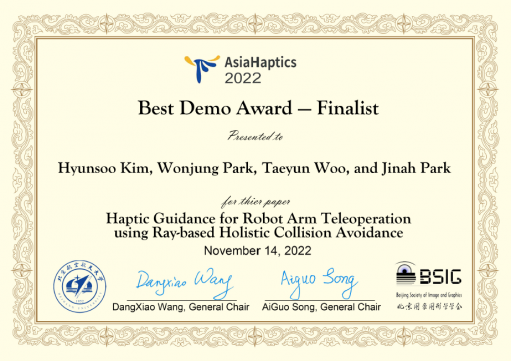
Asiahaptics 2022 Best Demo Award - Finalist
At the AsiaHaptics 2022 (http://www.asiahaptics2022.com/) demo session held in China, Japan, and Korea on the 11th (Friday), a demo of KAIST professor Park Jin-ah's lab paper won on the Finalist. Haptic Guidance for Robot Arm Teleoperation using Ray-based Holistic Collision Avoidance Hyunsoo Kim (doctoral program), Wonjung Park (doctoral program), Taeyun Woo (master's program), and Jinah Park Congratulations on winning the award.
...Read more -

Fluiz, founded by professor Insik Shin, won the CE..
KAIST start-up company Fluiz CES Innovation Award for New Technology for Smart Device Connectivity KAIST research team's technology, which won the best thesis award, won the CES Innovation Award one after another... Had their cake and ate it, which are technical and commercial Fluiz Inc., a startup founded by KAIST professor Insik Shin, won the CES 2023 Innovation Awards in the Software & Mobile Apps at the CES 2023, the world's largest new technology fair. The next-generation multi-device mobile platform FLUID (FLUID: Next-generation Multi-device Mobile Platform) developed by Fluiz is the world's first multi-device mobile platform that allows existing mobile apps that were used only within one smart device to be organically distributed across multiple smart devices. Typically, multiple UI (User Interface) elements of an app can be freely distributed and used on multiple devices, which is expected to evolve the existing mobile ecosystem that was stuck in a single-device-centered UX into a new multi-device paradigm. One of the innovative advantages of FLUID is that it does not require code modification to existing mobile apps. One of the innovative advantage of FLUID is that it does not require code modification to existing mobile apps. FLUID can immediately expand mobile apps on the market to a multi-device environment because the platform itself provides multi-device UX without modifying any code of existing mobile apps. Professor Insik Shin published "FLUID: Flexible User Interface Distribution for Ubiquitous Multi-device Interaction", which is about the technology used in the platform, at ACM MobiSys, MobiCom, the world's most prestigious academic societies in mobile communication and computing, and won the "MobiCom Best Paper Award" in September 2019 for the first time in Korea. Professor Shin In-sik established Fluiz, a KAIST startup, to commercialize the technology developed in the research, and will participate in this CES 2023 with the help of KAIST Industrial-Academic Cooperation Center.
...Read more -
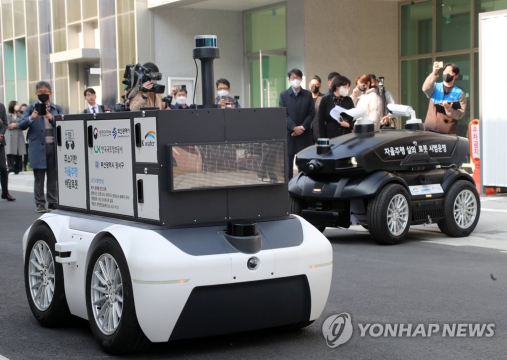
Self-driving Robot, Delivering Items from Convenie..
This is an article about address-based self-driving robot demonstration that Auto-ID Lab Korea, headed by Daeyoung Kim, professor of KAIST School of Computing who is in charge of the overall research." Self-driving robots deliver convenience store items (Busan = Yonhap News) Reporter Park Sungje = The Ministry of Public Administration and Security held an "demonstration of address-based autonomous robot delivery" using autonomous driving movement data at Eco Delta City Smart Village in Gangseo-gu, Busan on the 11th. This demonstration verified the process of self-driving robots delivering goods from convenience stores in the smart village to the front of the orderer's house. About 30 people, including Vice Minister of Public Administration and Security Changseop Han, Gangseo-gu District Mayor Hyungchan Kim, and KAIST researchers, attended the demonstration, assuming that a store owner who runs a convenience store alone operates a robot delivery service. a delivery robot loaded with goods When a user enters his or her home address and items he or she need on the delivery website using his or her smartphone, the convenience store owner checks them and loads the items on the robot and sends them to the user. An official from the Ministry of Public Administration and Security said, "Delivery services are expected to be effective if non-face-to-face is needed due to the spread of infectious diseases or families that are difficult to leave their homes due to baby care." The Ministry of Public Administration and Security plans to spread it by preparing infrastructure necessary for operation, such as self-driving patrol robots and cleaning robots. An official from the Ministry of Public Administration and Security said, "By the end of this year, we plan to build infrastructure related to address-based autonomous driving robots in Songpa-gu Seoul, Sejong-si Central Park, and Ulsan Taehwagang National Garden, and to demonstrate crime prevention and patrol robots." Reference https://www.yna.co.kr/view/AKR20221111102800051?input=1195m https://www.hani.co.kr/arti/area/yeongnam/1067258.html
...Read more -

KAIST Professor Meeyoung Cha and Sue Moon won the ..
In the early days of YouTube, she analyzed the characteristics of user-generated content platforms and won the best thesis award at the time The paper has been cited more than 2,000 times since its presentation, and it has been ranked as the third most cited paper in the conference Meeyoung Cha(left) and Sue Moon, professor of School of Computing at KAIST, who won the ACM Internet Measurement Society Test of Time Award KAIST announced on the 10th that Meeyoung Cha and Sue Moon, professors of the School of Computing, won the Test of Time Award at the ACM Internet Measurement Conference held in Nice, France. The award was first established this year as it is awarded to papers that have continued to exert influence for more than a decade. Professor Meeyoung Cha and Sue Moon are the first winners. The selected paper is “I Tube, You Tube, Everybody Tubes: Analyzing the World's Largest User Generated Content Video System” published in 2007. It is a paper that collected and analyzed two million video information and viewing statistics data posted on user-generated content (UGC) systems, including YouTube and Daum. Previously, the distribution of popularity of images was thought to follow the Pareto principle, also known as the 80:20 law. However, the study first confirmed that the top 10% of popular videos, which were more concentrated than 20%, accounted for 80% of the total views, and received the Best Paper Award at the time. In addition, the paper explained how new content markets such as YouTube differ from traditional content markets by citing the bottom 90% of popularity. Unpopular content is called a so-called long tail because it stretches like a tail behind the top 10% content that bulges in a curve of popularity distribution. The research team proved through experiments that the popular distribution of user-generated content initially follows the power-law, but over time, it turns into a truncated power-law due to factors such as platform ranking algorithms and information filtering. Through this, it was experimentally suggested that even content belonging to longtail can significantly increase the number of viewing views if it is recommended as an individualized algorithm to users. Test of Time Award This paper has influenced various industries, including caching and transmission of video content, ranking algorithms, and advertising exposure, over the past 15 years since its release. It has been cited more than 2,000 times so far, making it the third most cited study in the history of the Internet Measurement Association. Even 10 years after its announcement, it has been cited more than 600 times and has a steady influence. Professor Meeyoung Cha explained, "At the time of the study, YouTube was a new platform that had been in service for just two years, which was very different from its current status." She then said, "I am happy that the paper, that collecting and analyzing new data was challenging, has been loved and cited by fellow researchers for a long time." Cha led the study in 2007 with co-author Pablo Rodriguez and advisor Sue Moon while doing an internship in Telefonica, Spain. Currently, she is CI at the Institute of Basic Science (IBS) data science group. Researchers Haewoon Kwak and Yongyeol Ahn, who participated as co-authors at the time, are currently serving as professors at Singapore Business University and Indiana State University, respectively.
...Read more -
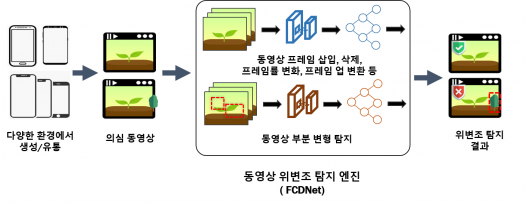
Catching forgery at KAIST, KaiCatch developed a te..
A research team led by Honorary Professor Heungkyu Lee (School of Computing KAIST) has developed a video forgery detection technology that detects frame-up conversion, interpolation, and forgery areas in images, which are used for malicious forgery, sponsored by KAIST startup Digital Innotec. It was also published in the November issue of Forensics Science International, the most prominent paper in the field of forgery and alteration. Along with the mass distribution of CCTVs, videos are used as major evidence in numerous disputes. However, along with the development of video editing tools and artificial intelligence technologies, malicious modulation technologies is coming out which make it more difficult to detect forgery by converting forgery videos into high-quality videos using the technology. This technology called frame-up conversion. In this study, the team presents four types of network blocks that continuously utilize spatial and temporal information, including editing modulation of specific areas in the video, adding and deleting frame. Also, they presented a frame-up detection neural network that extracts frame-up features and voting functions to detect frame-up transformations. The developed technology can perform video forgery detection at high speed. Especially since it reads integrity using information from extremely small areas of the video, the technology is useful and practical compared to existing technologies. This study is meaningful in that Dr. Minseok Yoon of KAIST and Dr. Seunghoon Nam of Naver Webtoon AI participated and greatly expanded the function of KaiCatch, which means capturing forgery in KAIST, forgery detection software to videos The developed technology was published in of Forensics Science International (November 2022 issue Vol 340), the most prominent paper in the field of image forgery, as a "Frame-rate Up-conversion Detection based on Convolutional Neural Network for Learning Spatial Features". This study was conducted with the support of the Korea Research Foundation's Creative Challenge Research Base Support Project and KAIST's startup company Digital Innotec.
...Read more -
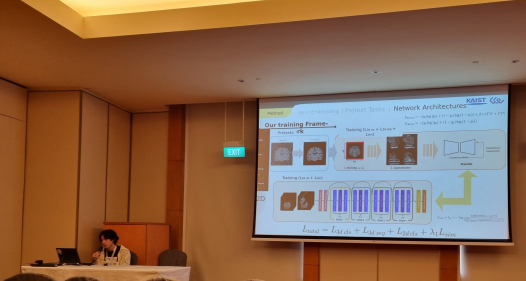
KAIST SoC team from CGV lab became co-champions in..
Professor Kang Inseok of KAIST Computer Science, and Professor Park Jinhoon of International School of MedicineHe won first place in the same category at the Medical Out-of-Distribution Analysis (MOOD) Challenge. It was one of the challenge of the 25th International Conference on Medical Image Computing and Computer Assisted Intervention (MICCAI 2022) which was held at the Singapore Resort World Convention Center from September 18 to 22 (MOOD) Challenge is a challenge to distinguish whether or not there is a lesion in the test image and locate the lesion, when the 3D medical image of normal brain and abdomen is given as learning data. The research team showed excellent performance in the Segmentation Task using the Join Embedding method that utilizes the advantages of both 2D and 3D networks, and became co-champions this year like we did last year (https://cs.kaist.ac.kr/board/view?bbs_id=news&bbs_sn=9946&page=1&skey=subject&svalue=mood&menu=83)), which won the first place in the MOOD 2021 Challenge. More information can be found on the Challenge website. (http://medicalood.dkfz.de/web/ )
...Read more -
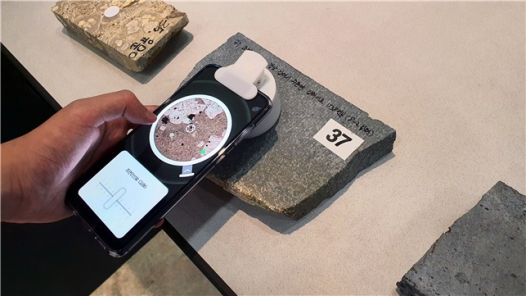
˝See through with smartphones˝, KAIST invented an ..
Reference : http://news.heraldcorp.com/view.php?ud=20220913000650 [Herald Economy = Reporter Koo Bon-hyuk] KAIST introduced that Professor Woohoon Lee of the Department of Industrial Design and Professor Kihyuk Lee of the Department of Computer Science have developed a new augmented reality device WonderScope that projects objects inside. If you install WonderScope on your smartphone, connect it with Bluetooth, and turn on the app, you can see the inside of exhibit like a magic lens. At the science museum, augmented reality apps can be experienced with smartphones or tablets. The app provides a unique viewing experience by adding digital information to actual exhibits. Visitors should view the mobile screen with a certain distance from the exhibition. There are often phenomena of focusing on digital content shown on the screen rather than on the exhibits themselves. Augmented reality apps can also cause visitors to move away from exhibits due to the distance between exhibits and mobile devices and the distraction between them. To solve this problem, a magic lens augmented reality that projects the inside from the surface of the exhibit is needed. WonderScope identifies the location of the smartphone on the surface of the exhibit in a much more practical way. First, the location is determined by reading a small RFID tag attached to the surface of the display, and the location of the moving smartphone is calculated by adding relative movement based on two optical displacement sensors and an acceleration sensor. The research team studied to calculate the location as accurately as possible considering the height of the smartphone and the characteristics of the surface of the exhibits. By attaching or embedding RFID tags on exhibits at the science museum, visitors can easily experience augmented reality effects such as magic lenses on their smartphones. The WonderScope can be located even at a range of about 4cm from the surface, enabling simple three-dimensional interaction near the surface of the exhibit. The research team has developed various case project templates and wonderscope usage support tools to easily produce smartphone apps using general-purpose virtual reality (VR) and game engine Unity. WonderScope can be used in conjunction with smartwatches, smartphones, and tablets with Android operating systems, so it can be applied in various forms to exhibits. A view of the inside of the mineral with a wonderscope.[Provided by KAIST] WonderScope is used as a tool to observe underground volcanic activities and the inside of volcanic rocks at the Special Exhibition of "There was a Volcano" held at the Geological Museum. In addition, it was used as a tool for observing the surface of broze mirror with fine linear design at the "bronze mirror, illuminate science" held at the National Science Museum, and exhibited contents for experiencing lunar landers at the "Moon Exploration Special Exhibition" WonderScope is a cylindrical accessory module with a diameter of 5cm and a height of 4.5cm, and is small enough to be easily attached to a smartphone, and most of them can be embedded in the exhibits without any problems. Professor Woohoon Lee said, "WonderScope will be able to be applied in various domains not only in education but also in commercial exhibitions. We expect it to be used as an interactive teaching tool that stimulates children's curiosity." nbgkoo@heraldcorp.com Related articles https://www.yna.co.kr/view/AKR20220913117400063 https://www.mk.co.kr/news/it/view/2022/09/807772/ https://www.etnews.com/20220913000114
...Read more -

Professor Min H. Kim's research team at our School..
Figure 1. SIGGRAPH 2022 Technical Paper Award Honorable Mention, Ph.D. candidate Inseung Hwang (the first author), and Professor Min H. Kim (the corresponding author) The research team led by Professor Min H. Kim of the KAIST School of Computing received the Technical Paper Award Honorable Mention with the work “Sparse Ellipsometry: Portable Acquisition of Polarimetric SVBRDF and Shape with Unstructured Flash Photography” at the 2022 ACM SIGGRAPH Conference held in Vancouver, Canada from August 8 to 11, 2022. ACM SIGGRAPH is the world's most renowned conference in the field of computer graphics, and this is the first time for a Korea-led research team to receive the Technical Paper Award in the 49-year history of this conference. The physical polarization component of light is being actively used in computer graphics and vision fields to more accurately reproduce hyper-realistic virtual human, object, and metaverse environment space. The polarization component measures information through the ellipsometric technique, and the existing technology has only been able to acquire it through a long scanning time of 2-5 days through an ultra-precise optical instrument. Also, the shape of an object that can be measured was limited to uniform materials made of spherical shapes. The research team has overcome these technical limitations and developed a three-dimensional imaging technology that can capture both polarimetric SVBRDF and 3D shape of various types of objects within minutes without using expensive professional imaging equipment. This research was conducted as joint research with the University of Zaragoza in Spain and Microsoft Research Asia in China. The work was presented orally at the ACM SIGGRAPH 2022 held in Vancouver, Canada from August 8 to 11, 2022, and was published in ACM Transactions of Graphics, which is one of the best journals in the field of graphics. In addition, it was awarded the Technical Paper Award Honorable Mention on August 11. Professor Min H. Kim, the corresponding author of this paper, said, "The proposed polarization-based 3D scanning technology is expected to accelerate the evolution of the existing computer graphics rendering technology, which is comfortable for human eyes, to a physically more accurate rendering technology. The transformation of the physically-based rendering paradigm for metaverse reproduction will enable the use of a new type of graphics technology that has never been considered before.” Project Site: http://vclab.kaist.ac.kr/siggraph2022p1/ Figure 2. The portable device for polarimetric SVBRDF acquisition and its image results presented at the SIGGRAPH 2022
...Read more -
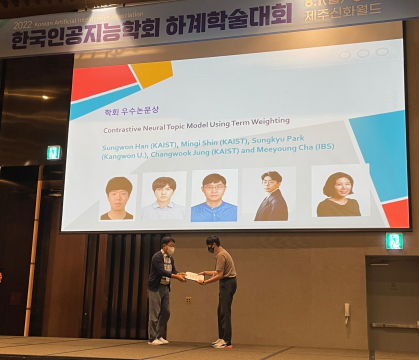
The Best Paper Award awarded at 2022 Summer Confer..
Sungwon Han (Integrated Master's and Doctorate Program at KAIST School of Computing), Mingi Shin (Master's Program KAIST School of Computing), Changwook Jung (Integrated Master's and Doctorate at KAIST School of Computing), Sungkyu Park (Professor of Kangwon National University, a graduate of KAIST Graduate School of Web Science), and Meeyoung Cha (Professor of KAIST School of Computing) were awarded the Best Paper Award for their research paper “Contrastive Neural Topic Model Using Term Weighting” at the 2022 Summer Conference of the Korean Artificial Intelligence Association held at Shinhwa World in Jeju for 3 days from August 1st. Korean Artificial Intelligence Association was founded in December 2016, and this year held its third conference. The conference was held with profound content including 4 tutorial lectures, 2 international conference best paper sessions, 10 planning sessions, and 1 workshop. Congratulations on winning the Best Paper Award.
...Read more -
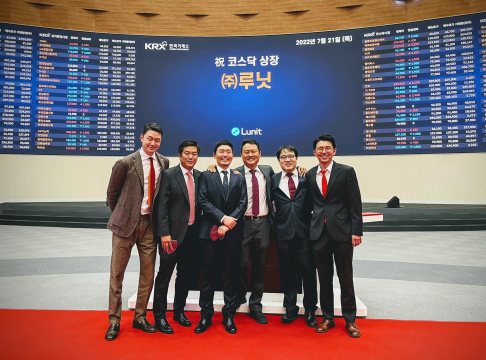
Medical AI company Lunit Inc. listed on KOSDAQ
CTO Jungin Lee at the ceremony (the second from right) Lunit Inc., a medical AI company, in which Jungin Lee, a graduate of our School (Advisor: Sung-Eui Yoon), is working as CTO was listed on the KOSDAQ market on July 21st. A celebration ceremony was held at the Korea Exchange in Yeouido on the same day. Founded in 2013, Lunit is a company that provides AI cancer diagnosis and treatment solutions based on deep learning technology. It developed and released an AI image analysis solution (Lunit INSIGHT) and an AI biomarker platform that predicts anticancer treatment responses (Lunit SCOPE). CTO Jungin Lee, also a founding member, first evolved the business theme during the “image search” lecture, which was first opened at KAIST School of Computing in 2011. To fully dedicate his time and effort to product development, he decided to leave his Ph.D. program. As a result of over 10 years of hard work, today, Lunit has grown into a company that is worth around 300 million dollars.
...Read more -
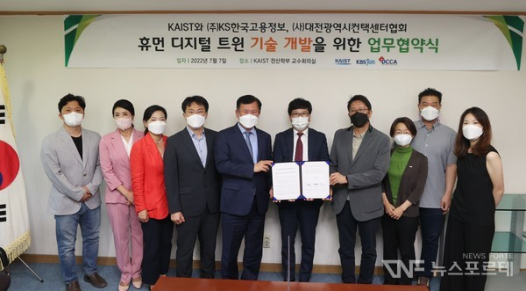
KAIST signs an MOU with KS Korea Employment Inform..
On July 7th, the research team led by Professor Uichin Lee of the KAIST School of Computing (Head: Sukyoung Ryu) signed a memorandum of understanding (MOU) for mutual exchange and cooperation with the KS Korea Employment Information and Daejeon Contact Center Association regarding 'Human Digital Twin Research for Emotional Workers'. Emotional workers, such as service center counselors and civil administration staff, have a higher prevalence of mental illness compared to those of other occupations because of high stress due to restraint of emotional expression during their job performance. According to data from the Occupational Safety and Health Research Institute in 2017, emotional workers who frequently deal with unhappy customers were 2.8 times and 3.8 times more likely to suffer from depression and sleep disturbances than those who did not. The Occupational Safety and Health Act was introduced in 2018, revealing the importance of mental health management for emotional workers, but the current system lacks personalized service that can actively support the act. Professor Uichin Lee's research team will develop a human digital twin technology that provides a virtual environment simulation for emotional labor stress and conduct research to demonstrate a personalized mental health risk management solution. Through the MOU, the three organizations will ▲ cooperate in R&D to develop and enhance AI-based emotional worker support services ▲ support on-site needs research to establish mental health management solutions ▲ collect research datasets for AI algorithm development ▲ cooperate in various fields, including in the demonstration of personalized mental health management solutions. In addition, KS Korea Employment Information (President: Youngdeuk Son, Jaejoong Yoo) has a large-scale professional human resource network that supports financial and public contact center outsourcing. It has been researching and developing contact center software and consulting solutions. The Daejeon Contact Center Association (President: Nam-gu Park) is in charge of training professional counselors in the Daejeon area and protecting human rights. Professor Uichin Lee said, “the foundation for field-oriented technology development has been laid through this MOU." “From now on, it will be possible to develop a mental health AI model with high prediction power through data collection at the working sites,” he added. Jaejoong Yoo, the president of KS Korea Employment Information, said, “We will lead the AI-based future contact center software technology by actively cooperating with KAIST in research and demonstration of digital solutions that support the mental health management of workers.” Nam-gu Park, the president of the Daejeon Contact Center Association, added, “I hope to inspire pride in workers with AI technology that can improve their mental health.” He gently expressed his request for research outcomes that can effectively prevent and manage stress in the working fields of the current contact service domains as well as other non-contact service industries in the future. From KAIST, Professor Dongman Lee (Head of College of Engineering), Sukyoung Ryu (Head of School of Computing), Professor Uichin Lee, Professor Sung-Ju Lee, Hwajung Hong, and Tak Yeon Lee attended the ceremony of MOU. President Nam-gu Park of Daejeon Contact Center Association and President Jaejoong Yoo of KS Korea Employment Information also joined the scene.
...Read more -
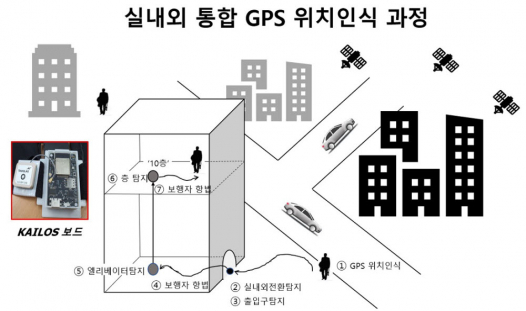
KAIST develops an Indoor/Outdoor Integrated GPS Sy..
KAIST announced on the 8th that a research team led by Professor Dong-soo Han (Intelligent Service Integration Lab) has developed an Indoor/outdoor integrated GPS system that enables precise location recognition regardless of indoor and outdoor environments. The indoor/outdoor integrated GPS system developed estimates the outdoor location using GPS signals and recognizes the indoor location by using signals obtained from an inertial sensor, barometric pressure sensor, geomagnetic sensor, and illuminance sensor in combination. The research team has developed indoor/outdoor detection, building entrance/exit detection, entrance floor level detection, stairs/elevator detection, and floor detection using artificial intelligence (AI) techniques. In addition, the so-called sensor-fusion location recognition algorithm was newly developed, which linked the various existing landmark detection techniques with Pedestrian Dead Reckoning (PDR) method. Before, it was common to recognize a location based on a wireless LAN signal or a cellular station signal in a space where the GPS signal did not reach. The indoor/outdoor integrated GPS system developed by the research team is the first technology that enables location recognition even in buildings without signals and indoor maps. The developed algorithm can provide accurate floor information within a building that Google and Apple location recognition services do not provide. Unlike vision, Earth's magnetic field, and wireless LAN positioning methods, it also has the advantage of not requiring prior preparation. The newly developed system lays the foundation to build a universal indoor and outdoor integrated GPS system that can be used anywhere in the world. The research team also manufactured an indoor/outdoor integrated GPS board equipped with GPS, Wi-Fi, and Bluetooth signal receiving chips, inertial sensors, barometric pressure sensors, geomagnetic sensors, and illuminance sensors. In addition, they loaded the sensor-fusion location recognition algorithm on the board. Results of measuring the location recognition accuracy of the HW board at the N1 building of the KAIST campus in Daejeon show that the system can achieve an accuracy of about 95% in floor estimation and about 3-6 meters accuracy in the horizontal direction. In the case of indoor/outdoor transitions, the transition latency of about 0.3 seconds was achieved. When the Pedestrian Dead Reckoning (PDR) method was integrated, the accuracy further improved up to 1 meter. The research team is planning to produce a tag with a built-in location recognition board and apply it to a location-based exhibition guide service for visitors to museums, science centers, and art galleries. The developed indoor/outdoor integrated GPS tags can be used for protecting children and the elderly, as well as for locating firefighters or workplace workers. In addition, the researchers are developing a sensor-fusion location recognition algorithm and board for vehicles to estimate the location of a vehicle in indoors such as in an underground parking lot. When the indoor/outdoor integrated GPS positioning board for vehicles is assembled, the research team will seek cooperation with car manufacturers and car rental companies. They will also develop a sensor-fusion location recognition tool that can be installed in smartphones. If the indoor/outdoor integrated GPS app is developed, cooperation with telecommunication companies seeking various commercialization in the field of location recognition will be possible. Professor Han said, “This is the first indoor/outdoor integrated GPS system that can recognize a location in a building where there is no wireless signal and indoor map. Its application fields are endless. If it is integrated with the Korean GPS (KPS) system, which is being developed since 2022, and the Korean Air Satellite Service (KASS), Korea can become a leading country in the field of indoor/outdoor integrated GPS." "We also plan to manufacture indoor/outdoor integrated GPS semiconductor chips to further widen the technology gap in the future,” he added. “The location-based guidance service for exhibitions, museums, and art galleries using the developed indoor/outdoor integrated GPS tag can be useful to analyze the trajectory of visitors. This is essential and useful information when replacing the exhibition contents. We will try our best to apply it to the National Science Museum as our priority,” he said. The indoor/outdoor integrated GPS system and location-based visitor trajectory analysis system were developed with the support of the Ministry of Science and ICT for the science and culture exhibition service capability enhancement support project.
...Read more -
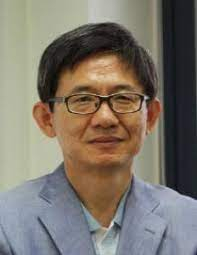
Professor Heung-Kyu Lee developed video manipulati..
KAIST (President: Kwang Hyung Lee) announced on the 13th that a research team led by KAIST SoC Professor Heung-Kyu Lee developed KaiCatch v2.1 (a new version of video image manipulation detection software KaiCatch) which has significantly improved video image accuracy/precision and video manipulation detection ability. KaiCatch v2.1 uses a new artificial intelligence structure and learning methodology, as well as advanced tempered images that are difficult to obtain in a laboratory environment. The following is an extract from the interview with Professor Heung-Kyu Lee, who developed KaiCatch v2.1. "Since March 2021, which is when KaiCatch, our first video image forgery software, was introduced to the public in the form of an Android app installed on mobile phones, over 900 cases of forgery analysis were requested through the KaiCatch app. We additionally received more than 60 precise forgery analysis requests. However, the actual detection accuracy was much lower than the theoretical value due to the high false detection rate. In many cases, it was impossible to make a clear technical determination about forgery or alteration. The newly developed KaiCatch v2.1 uses CAT-Net, a new network structure and learning methodology, and a cutting-edge technology called 'Simultaneous analysis of color and frequency domain distortion traces' to increase precision and enable clearer discrimination. We hope that difficult cases in video forgery detection will greatly reduce in the future.” This research was carried out jointly with Dr. Myung-Joon Kwon (the first author) and Professor Chang-ick Kim of the KAIST School of Electrical Engineering, as well as Dr. Seung-Hun Nam and Dr. In-Jae Yu. The work was published on May 25, 2022, in the online version of the International Journal of Computer Vision (IF 7.410), which is the top international journal in computer vision published by Springer Nature. (Paper title: Learning JPEG Compression Artifacts for Image Manipulation Detection and Localization) This research was conducted with the support of the National Research Foundation of Korea for the Creative Challenge Research Foundation Support Project and an industry-university cooperation research project with Digital Innotek, a KAIST startup company (http://www.kaicatch.com/). This work was promoted in telecommunication/broadcasting/online media and newspapers from June 13. Related articles were published in 20 media outlets such as the Dong-A Ilbo and the Electronic Times Internet.
...Read more -
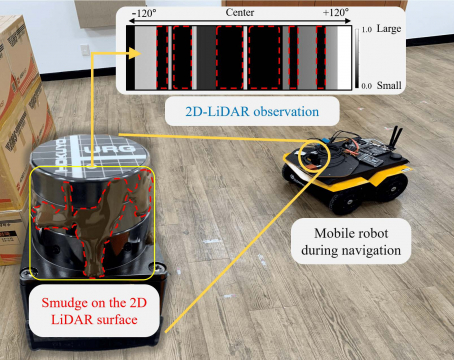
The master's thesis of Hyeongyeol Ryu (Advisor: Su..
The master's thesis of Hyeongyeol Ryu (advisor: Sung-Eui Yoon), a master's graduate of the School of Computing, was presented at the ICRA 2022 (IEEE International Conference on Robotics and Automation), the largest conference in robotics held in Philadelphia, USA from May 23 to 27. This research paper was selected for the Outstanding Navigation Award Finalist at the ICRA conference. Only 40 papers among 1500 papers from all categories presented at the conference are selected for this award. Confidence-Based Robot Navigation Under Sensor Occlusion with Deep Reinforcement Learning Hyeongyeol Ryu, Minsung Yoon, Daehyung Park, and Sung-Eui Yoon IEEE International Conference on Robotics and Automation (ICRA), 2022 http://sglab.kaist.ac.kr/CBN-DRL/ This work, which was co-conducted with a reinforcement learning professional Professor Daehyung Park of our school, presents a technology that ensures robots' operation even in case of sensor pollution due to a foreign substance. This research was carried out based on the capabilities accumulated from collaborating with professors and researchers in the field of robotics at KAIST for many years through government projects including, research on unmanned vehicles with Professor Hyunchul Shim (School of Electrical Engineering) since 2012, Humanoid project with Professor Sungho Cho (School of Computing) and Emeritus Junho Oh (Department of Mechanical Engineering), Drone project with Professor Hyun-Myung (School of Electrical Engineering), and Quadruped robot project with Professor Hae-Won Park (Department of Mechanical Engineering).
...Read more -

Professor Sang Kil Cha awarded IEEE Test-of-Time A..
< Professor Sang Kil Cha > Professor Sang Gil Cha of the Graduate School of Information Security at our School received the Test-of-Time Award at the IEEE Security & Privacy [1], the top conference in information security held in May of this year. Test-of-Time Award is awarded to the papers that have exerted the greatest influence in the field of information security over the past 10 years. The selected paper 'Unleashing Mayhem on Binary Code', which Professor Sang Gil Cha published in 2012, was the first in the world to propose an algorithm that automatically finds bugs in binary code and creates an exploit linked to the attack code [2]. The algorithm developed was the core algorithm used in global cyber security hacking contests including the CGC (Cyber Grand Challenge) [3], an artificial intelligence hacking competition. With this work as a starting point, Professor Cha has conducted various studies to develop technology to find bugs and vulnerabilities through binary analysis. He is currently developing 'B2R2', a native platform that can analyze various binary codes [4]. < Picture of Test-of-Time Award > < Reference > [1] 43rd IEEE Symposium on Security and Privacy: https://www.ieee-security.org/TC/SP2022/ [2] Awarded Publication 'Unleashing Mayhem on Binary Code': https://www.computer.org/csdl/proceedings-article/sp/2012/06234425/12OmNzcPAxU [3] Cyber Grand Challenge Homepage: https://www.darpa.mil/program/cyber-grand-challenge [4] B2R2 Github: https://github.com/B2R2-org/B2R2
...Read more -
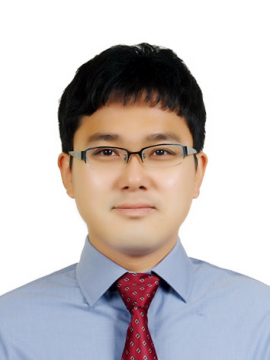
Professor Daehyung Park was selected as the recipi..
< Professor Daehyung Park > Professor Daehyung Park of our School was selected as the recipient of the 2022 Google Research Scholar Award. Google Research Scholar Program is an international program to support new professors who are conducting world-class research. This year, the program will support research on "Physics-Informed Interactive Skill Learning Toward In-hand Manipulation of Deformable Objects" by Professor Park's research team. This study proposes a method for learning the physical knowledge-based interaction skill of a robot hand for manipulating atypical objects. It will show manipulation techniques applicable in real life through the use of 1) physical knowledge-based reinforcement learning, 2) interaction-based reinforcement learning, and 3) Sim2Real transfer learning. The research plan will be updated at the URL below. https://rirolab.kaist.ac.kr/research/
...Read more -

Prof. In-Young Ko was inaugurated as the 18th pres..
Prof. In-Young Ko at the School of Computing was inaugurated as the 18th president of the KIISE Software Engineering Society on May 1, 2022. The KIISE Software Engineering Society is Korea's best academic organization in the field of software engineering. It was established in 1987 with the purpose of contributing to the nation's development by promoting academic, educational, and technological development related to software engineering. So far, the Software Engineering Society has provided a venue for active and systematic sharing of software engineering-related theories, experiences, and technologies among members in the field of software engineering at universities, research institutes, corporations, and government institutions. In particular, it hosts various events for software engineers such as the Korea Conference on Software Engineering (KCSE), summer short lectures, invited seminars, and evenings for software engineers, and regularly publishes newsletters. Professor Ko plans to make efforts to revitalize related events and activities in the post-corona era and the internationalization of the Software Engineering Society while serving as president for a two-year term.
...Read more -

Professor Kihong Heo's research team from KAIST Sc..
< Hyunsu Kim (left), Professor Kihong Heo (right) > In May 2022, a research team of KAIST SoC Professor Kihong Heo, his graduate student Hyunsu Kim, and researchers from the University of Southern California, published a paper and received the Best Artifact Award (thesis title: Learning Probabilistic Models for Static Analysis Alarms) at ICSE 2022 (The 44th ACM/IEEE International Conference on Software Engineering), the best academic conference in the field of software engineering. In this paper, the research team proposed a framework for the learning method of the Bayesian alarm ranking system to improve the usability of the SW error detection system using program static analysis, and demonstrated its excellence through systematic experiments. The Best Artifact Award is awarded to a research team recognized for their outstanding research achievements and contributions that have provided the basis for further research by transparently disclosing all implementations and data to academia. The Bayesian Alarm Ranking System is a next-generation software error detection system that Professor Heo's research team has been working on since 2018. Its achievements have been consistently recognized at the best international academic conferences for the past 5 years. In 2019, it was recognized for its academic excellence by receiving the best thesis award at the PLDI conference, the best academic conference in programming languages. In the most recent study, they proposed a learning algorithm that dramatically improves the performance of the system developed over the past five years. In addition, they were honored with the award which was given in recognition of the fact that all data and programs used in the experiment were made publicly accessible to subsequent researchers. Professor Kihong Heo, who is in charge of this research, emphasized, “We scientists are people who, as Newton said, ‘get on the shoulders of giants and see the world from afar'" and “our research was successful because there were records of existing researchers, which we highly appreciate for.” “It would be blissful for us if other follow-up researchers to step on our research artifacts and look further afield,” he added. Paper Link: https://conf.researchr.org/details/icse-2022/icse-2022-papers/62/Learning-Probabilistic-Models-for-Static-Analysis-Alarms Award Link: https://conf.researchr.org/track/icse-2022/icse-2022-awards?#icse-2022-best-artifact-awards
...Read more







